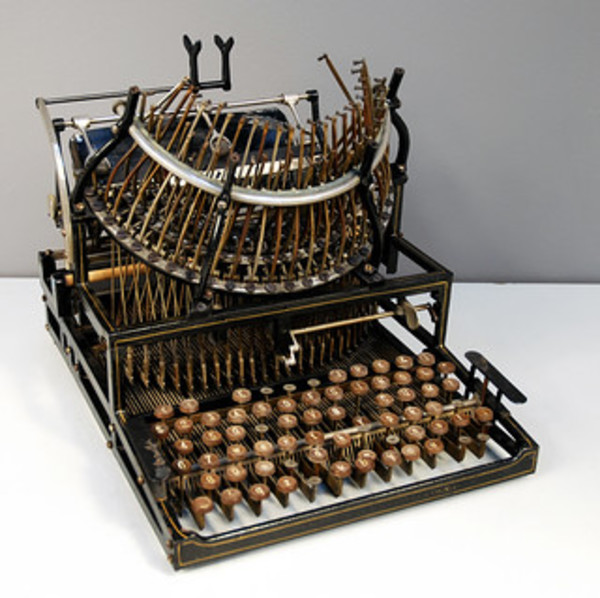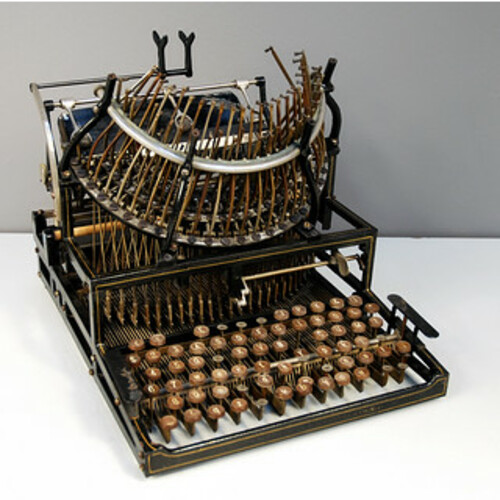
Source: Link
HORTON, EDWARD ELIJAH, newspaperman, court reporter, and inventor; b. 6 Aug. 1847 on Wolfe Island, Upper Canada, eldest child of Orin Horton and Sarah Ross; m. 25 June 1878 Emily Wardroper Smart (d. 1908) in Oakville, Ont., and they had four sons and a daughter; d. 27 June 1916 in Toronto.
Until his teenage years Edward Horton lived on Wolfe Island, near Kingston. By 1865 his father, formerly a dry goods and grocery merchant, had moved to Kingston as a labourer. Within five years the family had again relocated, to Toronto, and Edward began work as a reporter with the Globe. He became its city editor in 1873. He was working for the Mail in 1876 when he was commissioned to accompany Governor General Lord Dufferin [Blackwood*] on his trip to British Columbia; Horton’s unremarkable reports back to the Mail appeared between August and October. The vice-regal party returned via Chicago, where, probably at the Interstate Industrial Exposition Building, Horton may have seen and purchased his first “Type-Writer,” an early Remington model that typed on the hidden underside of the platen. (The first mass-produced typewriters had been sold in 1874.)
By 1879 Horton had begun work as a reporter (stenographer) in the provincial Court of Appeal in Toronto. A tinkerer, but no engineer, he was intrigued enough by the possibilities of typewriting in his profession to attempt design of a machine that would allow the operator to see what was being typed. In 1883, still working as a court reporter, he secured in the United States the first patents for a visible-typing apparatus in which obliquely placed type-bars struck from the front. He proceeded to refine this concept and brought to manufacture a machine of bold and open design. After securing the Canadian patent, in 1885 Horton and his reporter brother Albert incorporated the first Canadian company to manufacture typewriters, the Horton Typewriter Company, with its head office and factory in Toronto and a second factory in Buffalo, N.Y. By this time typewriting machines were becoming permanent fixtures in offices; in 1884 Horton’s sister, Elizabeth, was a “type writer” with the legal firm of Oliver Mowat* in Toronto.
For the Horton company, securing adequate capital to enter the American market and take advantage of its briefly held competitive edge was a major problem. In May 1887 the company was reorganized: the original machine was redesigned, a brochure was put into circulation, advertising appeared in Thomas Bengough’s Cosmopolitan Shorthander (Toronto and Boston), and the company was incorporated in New Jersey. Unaccountably, the brothers were persuaded to sell their American patents in August to a patent dealer, William Henry Cox. The only authoritative commentary on the failure of the company – Edward’s obituary, possibly based on information given by Albert – reads “but for want of capital it did not become a commercial success.” Profit margins were reduced by high production costs, and there may have been manufacturing shortcomings as well: of the six known surviving Horton machines, one has a cracked frame.
The Horton brothers continued their strategic planning and tinkering, however. In 1891 they secured patent protection in England for their original machine and for some improvements, including a mechanism “to raise the ink ribbon from the writing surface to inspect the characters hidden by said ink ribbon.” In addition, four years later, Edward obtained an early patent for a radial, steel-reinforced pneumatic tire. He was working on improvements to typewriters as late as 1898, when he secured a patent in the United States for an end-of-page indicator bell. Save for these patents and his brief foray into business, he remained a respected career stenographer in the Ontario courts. A member of the Ancient Order United Workmen and a devout Anglican, he attended St Peter’s Church in Toronto from at least 1890 to 1916, when he died following surgery.
As well as inventing and manufacturing Canada’s first, and only entirely Canadian, typewriter, Edward Horton had secured the first patents for a front-stroke machine that produced visible typing. His lasting impact was in placing machines on the market for others to see and emulate. His novel oblique, front-stroke configuration encouraged the development of what would evolve into the most successful typewriter design of the 20th century. It is unfortunate that he could not match his innovative design with the capital or business vision needed for commercial success.
Today, the Horton typewriter is an extremely rare machine: the author knows of only six in existence. Two of these are at the Onondaga Hist. Assoc. Museum, Syracuse, N.Y. (accession nos.1987.21.260 and 1987.21.365); another is in the IBM Coll. at the head office of the International Business Machines Corporation, Armonk, N.Y.; and three are in private collections.
Photographs of Edward Elijah Horton and his invention as well as other memorabilia and family papers are in the possession of Mrs Betty McFarlane of Belleville, Ont., a granddaughter of the subject.
AO, RG 22-305, no.32002; RG 55-17-63, no.3533 CP; RG 80-5-0-72, no.3546; RG 80-8-0-582, no.4332. Canadian Patent Office (Hull, Que.), Patent nos.22833 (11 Nov. 1885), 48280 (22 Feb. 1895). G.B., Patent Office (Newport, Wales), Patent no.17957-91 (20 Oct. 1891). NA, RG 31, C1, Toronto, 1891, St David’s Ward, sub-dist.22: 20; 1901, Ward 2, div.33: 17. National Arch. (Washington), RG 241 (records of the Patent Office), patent transfer, liber N-37: 132–34. N.J., State Dept., commercial recordings div. (Trenton), folder A4744 (Horton Typewriter Company). United States Patent and Trademark Office (Washington), Patent nos.285265 (18 Sept. 1883), 286824 (16 Oct. 1883), 605877 (21 June 1898). Globe, 28 June 1916. Mail (Toronto), 2, 15 Aug., 4, 11, 29 Sept., 4, 7 Oct. 1876.
M. H. Adler, The writing machine (London, 1973). Canadian Patent Office Record (Montreal; Ottawa), 13 (1885), no.22833; 23 (1895), no.48280. Cosmopolitan Shorthander (Toronto and Boston), 8 (1887): 103, 122, 204, 208, 235 (copies at Boston Public Library); also back cover of March 1887 issue (8, no.3), which shows an advertisement for the Horton typewriter (copy at the Library of Congress, Washington). [This source is the sole contemporary account of the marketing of the Horton typewriter in the United States. a.g.s.] Directory, Toronto, 1870–1916. Paul Lippman, American typewriters: a collectors’ encyclopedia (Hoboken, N.J., 1992). Ed Musgrave, “Unriddling the Horton typewriter,” Typewriter Times: Journal of the Anglo-American Typewriter Collectors’ Society (Hoboken and Beaconsfield, Eng.), no.17 (autumn 1989): 15–18 (no known public holdings; copy in possession of the author). [This is the only known biography of Horton; though somewhat embroidered and imaginative, it is valuable for its technical comparison between the early and late model Horton typewriters. a.g.s.] “Preliminary circular: a new and great invention; the Horton typewriter, the most perfect writing machine in the world” (printed pamphlet, 4pp., issued by the Horton Typewriter Company, Toronto and Buffalo, N.Y., [c. 1887]; copy in the possession of Betty McFarlane).
Cite This Article
Alexander G. Sellers, “HORTON, EDWARD ELIJAH,” in Dictionary of Canadian Biography, vol. 14, University of Toronto/Université Laval, 2003–, accessed December 28, 2025, https://www.biographi.ca/en/bio/horton_edward_elijah_14E.html.
The citation above shows the format for footnotes and endnotes according to the Chicago manual of style (16th edition). Information to be used in other citation formats:
| Permalink: | https://www.biographi.ca/en/bio/horton_edward_elijah_14E.html |
| Author of Article: | Alexander G. Sellers |
| Title of Article: | HORTON, EDWARD ELIJAH |
| Publication Name: | Dictionary of Canadian Biography, vol. 14 |
| Publisher: | University of Toronto/Université Laval |
| Year of publication: | 1998 |
| Year of revision: | 1998 |
| Access Date: | December 28, 2025 |



